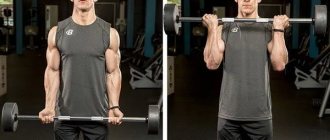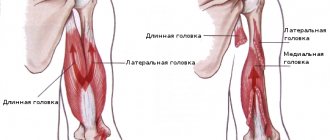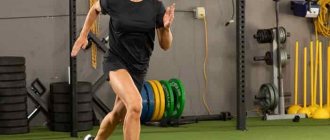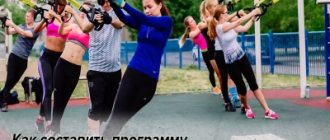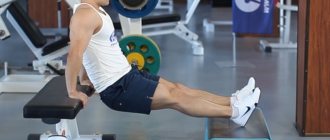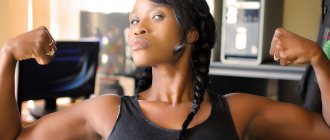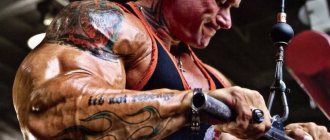In bodybuilding and fitness, the deltoid muscles occupy a special position. Despite the fact that the muscle area belongs to small groups, in terms of frequency of training it is second only to the biceps. The reason is not only the importance of the deltoid muscles in anatomy, but also to enhance the aesthetics of the figure. Understanding the functions and characteristics of the delta bundles allows you to maximize the effectiveness of the training process and significantly reduce the risk of injury.
Structure and functions
The deltoid muscle of the shoulder consists of three heads (bundles):
- Anterior or lateral (clavicular) – starts from the lateral part of the clavicle;
- Middle or acromial - starts from the acromial part of the scapula;
- Posterior or spinous - starts from the lower edge of the scapula bone.
Despite the fact that each head originates in different places, they are all attached by a common tendon to the deltoid (or V-shaped) tuberosity of the humerus. The delta muscles have a triangular shape, from which the group gets its name (the Greek letter “delta”).
Deltoid muscle structure photo
The functions of the deltoid muscles are considered, with specification of each bundle.
Front:
- lateral abduction of the arm during external rotation of the shoulder;
- shoulder internal rotation;
- shoulder antiversion (with the arm abducted);
- help the pectoral muscle flex the shoulder.
Average:
- abduction of the shoulder to the side (with the arm abducted).
Rear:
- shoulder extension;
- shoulder adduction (with the arm adducted);
- shoulder external rotation;
- abduction and retroversion of the shoulder (with the arm abducted).
In sports, a more simplified definition of functions is used. They are divided depending on where the head of the deltoid muscle is located. This division has some exceptions, but is generally suitable for understanding the functions of each head for athletes without specialized training.
- Forward (in front of) movements primarily engage the anterior head.
- Movements to the sides - medium.
Pulling the arm back in a raised position engages the posterior deltoid muscle.
Deltoid muscle, acromial part[edit | edit code]
Deltoid muscle, acromial part
Home[edit | edit code]
- Akromion
Attachment[edit | edit code]
- Deltoid tuberosity of the humerus
Innervation[edit | edit code]
- Axillary nerve, C5-C6
Features[edit | edit code]
The acromial part of the deltoid muscle (m. deltoideus) forms the relief of the lateral part of the shoulder girdle. When lifting heavy objects, it holds the head of the humerus in the glenoid cavity of the scapula.
| Functions | Synergists | Antagonists |
| Shoulder abduction (with the arm already abducted) | *M. deitoideus (spinous and clavicular parts with the arm already abducted) *M. infraspinatus (cranial part) *M. biceps brachii (long head) | *M. pectoralis major *M. latissimus dorsi *M. teres major *M. teres minor *M. coracobrachialis *M. biceps brachii (short head) *M. deitoideus (clavicular and spinous parts with the arm already adducted) *M. infraspinatus (caudal part) *M. triceps brachii (long head with arm already abducted) |
Shoulder abduction. Functional muscle tests[edit | edit code]
Issues and comments
- Do not allow the patient to externally rotate the arm, as this will engage the biceps brachii muscle.
- When testing the acromial deltoid, ensure that the patient does not elevate the shoulder or tilt to the opposite side, as this may appear to be shoulder abduction.
- The supraspinatus muscle serves as an assistant to the acromial part of the deltoid muscle.
Participation in sports[edit | edit code]
The acromial part of the deltoid muscle is involved in all sports that require abduction of the upper limb from the starting position (fencing, weightlifting) or holding the shoulder in an abducted position (archery, rifle shooting). This muscle plays an important role in all types of swimming, especially crawl and butterfly. When doing weightlifting, it centers the head of the humerus in the glenoid cavity of the scapula.
| Kind of sport | Movement/hold | Function | Load | Types of abbreviations |
| Fencing | Lunge | Shoulder abduction | Fast, explosive | Dynamic concentric |
| Weightlifting | Thrust phase | Shoulder abduction | Fast, explosive, maximum | Dynamic concentric |
| Handball | Throw | Shoulder stabilization | Fast | Dynamic concentric |
| Thrust phase | Stabilization of the humeral head in the glenoid cavity | Fast | Dynamic concentric | |
| Archery | Bowstring tension and aiming | Stabilization of the upper limb in abduction position | Strength endurance | Static |
| Rifle shooting | Stabilization of the upper limb in the shooting position | Stabilization of the upper limb in abduction position | Strength endurance | Static |
| Swimming | Breaststroke, backstroke - carry phase | Shoulder flexion, shoulder abduction | Strength endurance | Dynamic concentric |
| Swimming crawl or butterfly - carry phase | Shoulder abduction | Strength endurance | Dynamic concentric |
Top exercises for deltoids
All movements are divided into categories, depending on where the head of the deltoid muscle is located. Even basic exercises cannot load all three bundles evenly, so the work on each head is divided (even training on different days).
Basic exercises (using beams)
- Military press or barbell/dumbbell press in a standing or seated position (middle, front).
- Seated overhead press (middle, front).
- Barbell row to the chin or “pull” (middle, front).
- Lee Haney Deadlift (back, middle).
- Arnold press (front, middle).
Isolation exercises (taking into account the anatomy of the deltoid muscles of the shoulders)
- Raise a dumbbell in front of you - front bun.
- Raise your arm in front of you in the lower block of the crossover - front.
- Hand abduction to the side – average.
- Bent-over dumbbell raises – rear.
- Dumbbell row in a lying position with support (with elbows pointed to the sides) - back.
- Reverse spreads in Peck-Deck – rear.
All other exercises are duplicates. That is, when the conditions for performing a movement change, the load on specific delta beams does not change in any way. For example, abducting the arm to the side in a bend over with a dumbbell and a lower block.
Iron Health
The deltoid muscles belong to the category of muscle groups whose bundles can be trained separately. In this case, a separate training program can be used for each beam of deltas.
The use of specialized complexes for a specific area of the deltoid muscles may be due to the backwardness of this area or the desire of the athlete to specifically pump up each specific bundle. In this article we will analyze a training program for the mass of the anterior deltoid muscle.
Principles of training the anterior deltas
The mass training complex for the anterior deltoids will be based on the following basic principles:
- High intensity training - this means that the basic exercises should be performed with maximum working weight in the middle repetition range - 6-8 times.
- Specialized exercises - the program includes a set of exercises that specifically load the anterior deltoid muscles.
- Emphasis on the negative phase of the exercises - during working repetitions, do not throw the weight down, but lower it a little slower than usual.
- Using stretching at the end of the complex - stretching exercises at the end of the workout will lead to large micro-tears of the fibers, increase the speed of muscle recovery and increase their strength potential.
Anterior deltoids training program
| Exercises | Approaches | Repetitions | Rest between sets |
| Army press | 3 | 6 | 3 min |
| Arnold press | 3 | 8 | 2.5 min |
| Alternately lifting dumbbells in front of you | 3 | 12 | 2 minutes |
| Deltoid stretch | 3-4 min | ||
Technique for performing the exercises presented in the set:
- Army press
- Arnold press
- Front dumbbell raises
Answers to frequently asked questions about the complex
Below are answers to possible questions about this complex:
- When to run this program?
This training complex can be performed on a separate day, or on days of training the back or leg muscles. The best option would be to combine this program with a back program.
- How long to run this program?
The duration of the complex is 6 weeks. At the end of this period, you must change the program to another.
- What sports nutrition should you take?
Take protein and creatine at the end of your workout. This will create additional conditions for muscle growth and will contribute to the effectiveness of the workout.
What You Should Know About Training Your Deltoid Muscles
- The main problem of many gym goers is the presence of a good anterior deltoid, a good middle deltoid and a weak posterior deltoid muscle.
- Know that you have disproportionate development if, when you stand relaxed, the front sides of your palms face more back.
- When performing forward raises, lift the weight at an angle of 110˚ instead of the 90˚ angle that most people usually stop at.
- Maximize the work of your rear deltoids by keeping your shoulders out to the sides at an angle of 30-45˚.
- Most weightlifters perform lateral raises incorrectly. The wrist, elbow and shoulder should be level at the top, and the point of the elbow should be pointing straight back.
- People with hypertrophied upper trapezius muscles squeeze dumbbells during lateral raises. To avoid this, consider pushing the dumbbells away from you.
3D Deltas
The key to developing deltoids that have a three-dimensional appearance is the proportional development of all three deltoid muscle bundles. This will make your shoulders look full when viewed from the front, side or back.
Cosmetically, the most common pattern of maldevelopment of the deltoids is well-developed front deltoids, moderately developed middle deltoids, and severely underdeveloped rear deltoids.
This usually manifests as a significant inward rotation of the shoulders. In other words, your palms face more backward when you are relaxed.
This is possible if:
- Do you love the bench press and chest training in general?
- you tend to focus more on training the muscles you see in the mirror
Another option is to train the shoulders without stressing the front delts, giving priority to the development of the middle deltoid until it becomes thick, and the front deltoid remains underdeveloped, especially when viewed from the side.
Rate your selfies
Before you start training your shoulders, you should find out which of the deltoid bundles is lagging behind in development. To prioritize.
Take your picture with your arms at your sides and your arms facing your body. Take additional photos of the front, back and sides. This way you can evaluate seeing yourself from all sides, and then after a while compare the results of your training. When viewed from the front, the shoulders should have a rounded appearance.
If your shoulders have a narrow bone structure and/or you have a wide hip structure, then beautifully rounded deltoids are what you need.
You should pump up your deltoids, paying special attention to the middle deltoids using lateral lifts
On the other hand, if you look from the side and the front of your shoulders are not arched enough, then you need to focus on the front deltoid. Use different variations of dumbbell and barbell front raises to train your anterior deltoid muscles.
If you need to tone your rear delts, use dumbbell rows to train the back of your shoulders.
Double biceps back
Keep in mind when assessing your rear deltoid, it is usually a short muscle with a different appearance than the anterior deltoid. So don't expect them to look the same as your front delts. To evaluate how well your rear delt is pumped, use the rear double biceps pose.
Let's look at what the deltoid muscle is and what it is responsible for.
The name deltoid muscle comes from the Latin name musculus deltoideus, which means the superficial muscle of the shoulder, which forms the outer contour of the shoulder.
The deltoid muscle takes part in extension and flexion of the shoulder, and its abduction to the sides. The deltoid muscle is located on top of the shoulder joint.
The shape of the deltoid muscle is like an inverted Greek letter “delta” - hence the name of this muscle.
Anatomy of the deltoid muscle
There are three bundles in this muscle:
- Front beam;
- Side (middle) beam;
- Back bun.
Arnold press
Purpose of the exercise: Development of the anterior and middle delta bundles. Also assisting muscles are: trapezius, triceps, upper pectoralis major, coracobrachialis and serratus anterior.
This exercise became popular thanks to Arnold Schwarzenegger and has firmly established itself in the hearts of many fitness and bodybuilding lovers. If performed correctly, the tension in the shoulders will be constant, and the range of motion is very favorable for building muscle mass.
Initial position:
- Sitting on a bench with a strictly vertical back, pressing your back tightly against it.
- Bend your knees at a right angle, spread them wide and place your feet firmly on the floor.
- Raise the dumbbells to neck level. Bend your elbows at a right angle.
- Turn your hands with your palms facing you.
Technique:
- As you exhale, press the dumbbells vertically upward, while turning your hands with your palms facing outward.
- At the top point, your palms should be facing forward. Take a short break.
- As you inhale, smoothly return the dumbbells to their original position, turning your palms in the reverse order.
Recommendations:
- It is recommended to take lighter dumbbells than usual.
- At the top point, the elbows should not be straightened completely: leave them slightly bent.
- The press is performed smoothly, preferably without a pause at the bottom point. Jerks and accelerations will cause the load to be transferred to the spine.
Deltoid muscle: what is it, where, how does it work?
The main muscles of the shoulder are the biceps (biceps), triceps (triceps) and deltoid. There are also others that lie a little deeper. For example, the coracobrachialis, teres minor, supraspinatus and infraspinatus muscles, which attach to the back and shoulder. But that's not the point. We are interested in “deltas”: they are usually called that in gyms for ease of explanation and understanding.
Each of these sections performs its own functions, but in general, all sections of the deltoid muscles always work together, even in isolation exercises. Therefore, it is difficult to separate them: it is impossible, for example, to say that the rear delta moves the arm back, but the middle one does not do this. No, these shoulder muscles are always fully involved in work, although some individual bundles receive most of the load.
In addition, when working on the shoulders (swings or lifting dumbbells in different directions), the trapezius muscles provide significant assistance, even, I repeat, in isolating exercises.
The functions are simple: all movements that you are able to do with your shoulders occur with the direct participation of these muscles. Even when rotating the forearm. Right now, raise your straight arm forward with your thumb up (as if to show “class”). Place your left palm completely on the right deltoid (grab your shoulder). Now rotate your forearm so that your thumb points to the left. Did you feel the movement of the deltas?


